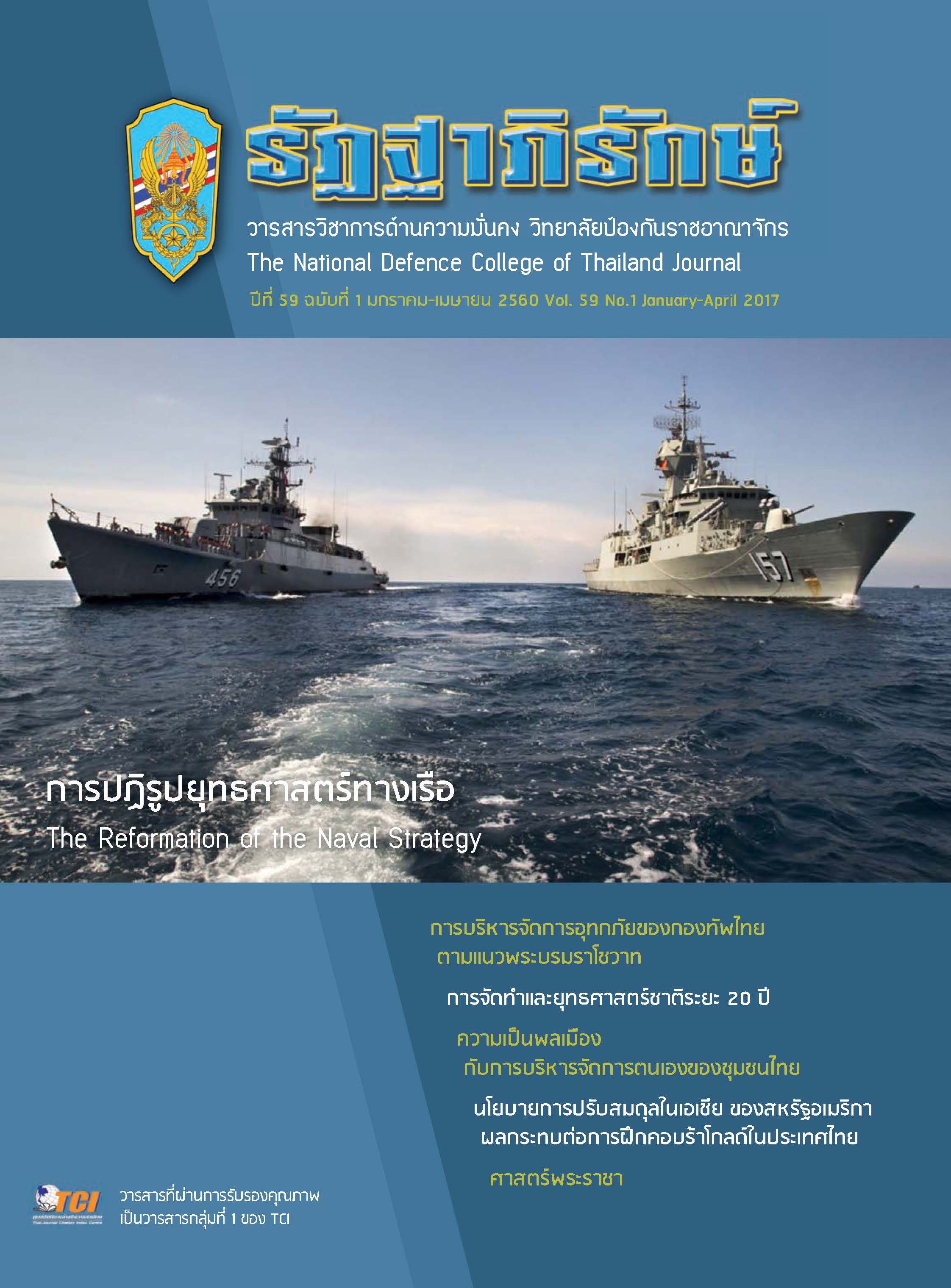การปฏิรูปยุทธศาสตร์ทางเรือ
The Reformation of the Naval Strategy
คำสำคัญ:
ยุทธศาสตร์ทางเรือ, ยุทธศาสตร์ทะเล, แนวคิดในการปฏิบัติการทางเรือในอนาคต, ยุทธศาสตร์แบบวงแหวน, การจัดทำยุทธศาสตร์แบบเน้นภัยคุกคาม, การจัดทำยุทธศาสตร์แบบเน้นขีดความสามารถ, Naval Strategy, Maritime Strategy, Future Naval Operational Concept, Threat - Based Strategic Planning, Capability - Based Strategic Planningบทคัดย่อ
บทคัดย่อ
การวิจัยเรื่องการปฏิรูปยุทธศาสตร์ทางเรือ มีวัตถุประสงค์ของการวิจัยเพื่อศึกษาวิเคราะห์การกำหนดยุทธศาสตร์ทางเรือและยุทธศาสตร์ทะเล ศึกษาความไม่สมบูรณ์สอดคล้องระหว่างยุทธศาสตร์ทั้งสอง และเพื่อศึกษาหาแนวทางในการปฏิรูปการกำหนดยุทธศาสตร์ทางเรือให้สอดคล้องรองรับกับการเปลี่ยนแปลงสภาวะแวดล้อมความมั่นคงทางทะเล และการรักษาผลประโยชน์ของชาติทางทะเลให้ได้มาซึ่งการกำหนดกำลังรบทางเรือที่เหมาะสม การวิจัยเป็นการวิจัยเชิงคุณภาพ (Qualitative Research) และการวิจัยเชิงพรรณนา (Descriptive Research)
ผลการวิจัยพบว่า การกำหนดยุทธศาสตร์ทางเรือยังขาดความสมดุลระหว่างการเตรียมกำลังรบทางเรือ กับการใช้กำลังรบทางเรือ โดยผู้จัดทำยุทธศาสตร์ทางเรือที่ผ่านมาในทุกครั้งจะเน้นพิจารณาแต่เพียงการเตรียมกำลังรบหรือการกำหนด/จัดหากำลังรบเพียงอย่างเดียวเท่านั้น ไม่มีการนำหลักการใช้กำลังทางเรือมาร่วมพิจารณา ทำให้ยุทธศาสตร์ขาดมุมมองในด้านการใช้กำลังทำการรบในอนาคต และการนำแนวคิดในการปฏิบัติการรบทางเรือในอนาคต (Future Naval Operational Concepts: FNOC) การจัดทำยุทธศาสตร์ทางเรือจะต้องเปลี่ยนการจัดทำจากแบบเน้นภัยคุกคาม (Threat-Based Strategic Planning) มาเป็นแบบเน้นขีดความสามารถ (Capability-Based Planning) ให้สอดคล้องกับสภาวะแวดล้อมด้านความมั่นคงในปัจจุบันและอนาคตที่ต้องการความร่วมมือ โดยเฉพาะประชาคมอาเซียน มากกว่าการตั้งตัวเป็นศัตรูที่ขาดความไว้วางใจกัน และต้องนำหลักการด้านความสัมพันธ์ระหว่างประเทศ การทูตเชิงป้องกัน (Preventive Diplomacy) การทูตทางเรือ (Naval Diplomacy) การสร้างความไว้เนื้อเชื่อใจ (Confidence Building Measures: CBMs) มาใช้ประกอบการจัดทำยุทธศาสตร์ทางเรือ เพื่อกำหนดนโยบายของกองทัพเรือ (ที่สอดคล้องกับนโยบายรัฐบาล) ที่มีต่อประเทศเพื่อนบ้านและประเทศต่าง ๆ ในภูมิภาคและในโลก ในลักษณะ Selective Engagements ซึ่งจะทำให้เกิดความชัดเจนในการปฏิบัติทางทหารต่อประเทศเพื่อนบ้านหรือประเทศต่าง ๆ ตั้งแต่ยามสงบไปจนถึงสภาวะความขัดแย้งหรือสงคราม ตาม Spectrum of Conflicts โดยใช้แนวทางของยุทธศาสตร์แบบวงแหวน (Ring-Fenced Strategy) โดยการกำหนดพื้นที่ความสัมพันธ์เป็นวง ๆ ตั้งแต่ชั้นในออกไปถึงชั้นนอก ตาม Employment Contexts (EC) ของแต่ละพื้นที่ รวมทั้งการตอบสนองทางทหารและการรักษาผลประโยชน์ทางทะเลต่อพื้นที่ EC นั้น ๆ ซึ่งจะได้ขีดความสามารถทางทหารและลักษณะของกำลังรบที่ต้องการ ผลการวิจัยได้เสนอตัวแบบ (โมเดล) ที่ตอบวัตถุประสงค์การวิจัยตามภาพที่ 1 ภาพที่ 2 และตามภาพที่ 3
ข้อเสนอแนะ กองทัพเรือควรร่วมมือกับ สมช. เร่งปฏิรูปการจัดทำยุทธศาสตร์ทางเรือใหม่ให้สมบูรณ์ตามแนวทางวิจัยนี้ โดยให้มีความสอดคล้องกันทั้งยุทธศาสตร์ทางเรือและแผนความมั่นคงแห่งชาติทางทะเล พ.ศ. 2558-2564 โดยเฉพาะในประเด็นแนวคิดในการใช้กำลังทางเรือและกำลังทางทะเล และหารืออนาคตของการจัดทำยุทธศาสตร์ทางเรือและยุทธศาสตร์ทะเล ในประเด็นการมียุทธศาสตร์ทะเล เพียงยุทธศาสตร์เดียว รวมทั้งต้องจัดทำ Future Naval Operational Concept: FNOC ขึ้นเป็นประจำ เพื่อสนับสนุนกระบวนการจัดทำยุทธศาสตร์ รวมทั้งของกำลังรบทางบกของกองทัพเรือ
คำสำคัญ: ยุทธศาสตร์ทางเรือ, ยุทธศาสตร์ทะเล, แนวคิดในการปฏิบัติการทางเรือในอนาคต, ยุทธศาสตร์แบบวงแหวน, การจัดทำยุทธศาสตร์แบบเน้นภัยคุกคาม, การจัดทำยุทธศาสตร์แบบเน้นขีดความสามารถ
Abstract
The research title “The Reformation of the Naval Strategy” has 2 objectives 1) to study and analyze Thailand Naval and Maritime Strategies and study of their imbalances and relevancies. 2) to study how to reform the current Naval Strategy to meet the new strategic environment and maritime interests and to find out the suitable Naval and Maritime Forces. This research is a Qualitative Research writing in Descriptive manner.
Research findings: The Thailand Naval Strategy is imbalance between the Force Planning and the Use of Force. The Naval Strategy planners used to formulate the strategy only in the aspect of the force planning without the use of force aspect. This causes the lacking of the future use of force and Future Naval Operational Concepts (FNOC) in the formulation. The Threat-Based Strategic Planning must be transformed to the Capability-Based Strategic Planning to meet current strategic security environment especially the existing of ASEAN Community rather than imposing threat and untrusted among all neighbor countries.The introduction of International Relations, Preventive Diplomacy, Naval Diplomacy and Confidence Building Measures (CBMs) should be included in the formulation process of making Naval Strategy and Naval Policy which related to the Government Policy.
Selective Engagements will be the concept of implementation clearly applied to all neighbors and countries from peacetime to the time of conflict or war according to the Spectrum of Conflicts. The Ring-Fenced Strategic concept of area divisions applying the Employment Contexts (EC) to each area with different political and military relations can be the new strategic formulation approaches to make force planning more effective. The findings propose new models of rebalancing and reformation of Naval Strategy according to the Pic. 1, Pic. 2 and Pic. 3.
Recommendations: Royal Thai Navy should cooperate with National Security Council in order to generate the new reform of the Naval Strategy through this thesis findings emphasize on the relevancy of both Naval Strategy and National Maritime Security Plan 2015-2021 regarding the Future Use of Naval and Maritime Forces and the possibility of the combination into only one strategy of Maritime Strategy including the making of Future Naval Operational Concept (FNOC) implementing to the Naval/Maritime Strategy will make the strategy balance and support future force planning effectively.
Keywords: Naval Strategy, Maritime Strategy, Future Naval Operational Concept, Threat - Based Strategic Planning, Capability - Based Strategic Planning
ดาวน์โหลด
เผยแพร่แล้ว
ฉบับ
ประเภทบทความ
สัญญาอนุญาต
บทความ ข้อเขียน หรือความคิดเห็นในนิตยสารนี้เป็นของผู้เขียน ไม่ผูกพันกับวิทยาลัย ป้องกันราชอาณาจักรและทางราชการแต่อย่างใด



